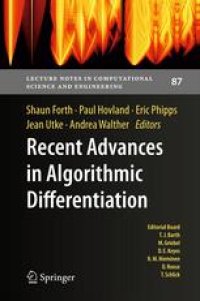
Ebook: Recent Advances in Algorithmic Differentiation
Author: Bruce Christianson (auth.) Shaun Forth Paul Hovland Eric Phipps Jean Utke Andrea Walther (eds.)
- Tags: Computational Mathematics and Numerical Analysis, Computational Science and Engineering, Optimization, Mathematical Software, Numeric Computing, Programming Languages Compilers Interpreters
- Series: Lecture Notes in Computational Science and Engineering 87
- Year: 2012
- Publisher: Springer-Verlag Berlin Heidelberg
- Edition: 1
- Language: English
- pdf
The proceedings represent the state of knowledge in the area of algorithmic differentiation (AD). The 31 contributed papers presented at the AD2012 conference cover the application of AD to many areas in science and engineering as well as aspects of AD theory and its implementation in tools. For all papers the referees, selected from the program committee and the greater community, as well as the editors have emphasized accessibility of the presented ideas also to non-AD experts. In the AD tools arena new implementations are introduced covering, for example, Java and graphical modeling environments or join the set of existing tools for Fortran. New developments in AD algorithms target the efficiency of matrix-operation derivatives, detection and exploitation of sparsity, partial separability, the treatment of nonsmooth functions, and other high-level mathematical aspects of the numerical computations to be differentiated. Applications stem from the Earth sciences, nuclear engineering, fluid dynamics, and chemistry, to name just a few. In many cases the applications in a given area of science or engineering share characteristics that require specific approaches to enable AD capabilities or provide an opportunity for efficiency gains in the derivative computation. The description of these characteristics and of the techniques for successfully using AD should make the proceedings a valuable source of information for users of AD tools.
The proceedings represent the state of knowledge in the area of algorithmic differentiation (AD). The 31 contributed papers presented at the AD2012 conference cover the application of AD to many areas in science and engineering as well as aspects of AD theory and its implementation in tools. For all papers the referees, selected from the program committee and the greater community, as well as the editors have emphasized accessibility of the presented ideas also to non-AD experts. In the AD tools arena new implementations are introduced covering, for example, Java and graphical modeling environments or join the set of existing tools for Fortran. New developments in AD algorithms target the efficiency of matrix-operation derivatives, detection and exploitation of sparsity, partial separability, the treatment of nonsmooth functions, and other high-level mathematical aspects of the numerical computations to be differentiated. Applications stem from the Earth sciences, nuclear engineering, fluid dynamics, and chemistry, to name just a few. In many cases the applications in a given area of science or engineering share characteristics that require specific approaches to enable AD capabilities or provide an opportunity for efficiency gains in the derivative computation. The description of these characteristics and of the techniques for successfully using AD should make the proceedings a valuable source of information for users of AD tools.
The proceedings represent the state of knowledge in the area of algorithmic differentiation (AD). The 31 contributed papers presented at the AD2012 conference cover the application of AD to many areas in science and engineering as well as aspects of AD theory and its implementation in tools. For all papers the referees, selected from the program committee and the greater community, as well as the editors have emphasized accessibility of the presented ideas also to non-AD experts. In the AD tools arena new implementations are introduced covering, for example, Java and graphical modeling environments or join the set of existing tools for Fortran. New developments in AD algorithms target the efficiency of matrix-operation derivatives, detection and exploitation of sparsity, partial separability, the treatment of nonsmooth functions, and other high-level mathematical aspects of the numerical computations to be differentiated. Applications stem from the Earth sciences, nuclear engineering, fluid dynamics, and chemistry, to name just a few. In many cases the applications in a given area of science or engineering share characteristics that require specific approaches to enable AD capabilities or provide an opportunity for efficiency gains in the derivative computation. The description of these characteristics and of the techniques for successfully using AD should make the proceedings a valuable source of information for users of AD tools.
Content:
Front Matter....Pages i-xvii
A Leibniz Notation for Automatic Differentiation....Pages 1-9
Sparse Jacobian Construction for Mapped Grid Visco-Resistive Magnetohydrodynamics....Pages 11-21
Combining Automatic Differentiation Methods for High-Dimensional Nonlinear Models....Pages 23-33
Application of Automatic Differentiation to an Incompressible URANS Solver....Pages 35-45
Applying Automatic Differentiation to the Community Land Model....Pages 47-57
Using Automatic Differentiation to Study the Sensitivity of a Crop Model....Pages 59-69
Efficient Automatic Differentiation of Matrix Functions....Pages 71-81
Native Handling of Message-Passing Communication in Data-Flow Analysis....Pages 83-92
Increasing Memory Locality by Executing Several Model Instances Simultaneously....Pages 93-101
Adjoint Mode Computation of Subgradients for McCormick Relaxations....Pages 103-113
Evaluating an Element of the Clarke Generalized Jacobian of a Piecewise Differentiable Function....Pages 115-125
The Impact of Dynamic Data Reshaping on Adjoint Code Generation for Weakly-Typed Languages Such as Matlab....Pages 127-138
On the Efficient Computation of Sparsity Patterns for Hessians....Pages 139-149
Exploiting Sparsity in Automatic Differentiation on Multicore Architectures....Pages 151-161
Automatic Differentiation Through the Use of Hyper-Dual Numbers for Second Derivatives....Pages 163-173
Connections Between Power Series Methods and Automatic Differentiation....Pages 175-185
Hierarchical Algorithmic Differentiation A Case Study....Pages 187-196
Storing Versus Recomputation on Multiple DAGs....Pages 197-207
An Integer Programming Approach to Optimal Derivative Accumulation....Pages 209-219
Java Automatic Differentiation Tool Using Virtual Operator Overloading....Pages 221-231
High-Order Uncertainty Propagation Enabled by Computational Differentiation....Pages 233-240
Generative Programming for Automatic Differentiation....Pages 241-250
AD in Fortran: Implementation via Prepreprocessor....Pages 251-260
Computing Derivatives in a Meshless Simulation Using Permutations in ADOL-C....Pages 261-271
Lazy K-Way Linear Combination Kernels for Efficient Runtime Sparse Jacobian Matrix Evaluations in C++....Pages 273-284
Implementation of Partial Separability in a Source-to-Source Transformation AD Tool....Pages 285-295
Back Matter....Pages 297-307
....Pages 309-319